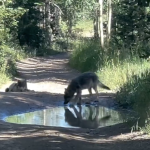Top 5 most-read stories last week: School bus law, meteor shower and remains found at Officers Gulch

Summit County Sheriff’s Office/Courtesy photo
Stories in this list received the most page views on SummitDaily.com from Aug. 3-9.
1. Colorado State Patrol reminds drivers of new law related to stopping for school buses
As Colorado students head back to school, the Colorado State Patrol is reminding drivers that a new law is in effect related to how to stop for school buses.
The new law, SB 25-1230, was enacted in May. It requires drivers who are approaching a school bus from an oncoming lane to stop unless there is a physical barrier separating the opposing directions of traffic.
If there are painted lines or a painted median separating the opposing directions of traffic, drivers approaching from the oncoming lane must stop. Only when there is a median that is either raised or depressed or a physical barrier separating the lanes can drivers from the oncoming lane continue with caution.
The goal of the new law is to protect children traveling on school buses. Over the last five years, there have been five crashes involving school buses that resulted from drivers failing to stop for a stopped school bus displaying flashing red lights, according to the State Patrol.
Under Colorado law, drivers must stop at least 20 feet before reaching a school bus that is stopped with its red lights flashing, whether it is on the side of the road, the opposite side of the road or at an intersection.
— Ryan Spencer
2. Property belonging to missing Vail man found next to human remains near Officers Gulch
The Summit County Sheriff’s Office stated in a Facebook post Wednesday, Aug. 6, that it and other agencies found human remains in a “steep and remote” area above Officers Gulch.
A report Aug. 2 of possible human remains led to the Sheriff’s Office, Summit County Coroner’s Office, Summit County Rescue Group, Vail Police Department and a forensic anthropologist from Mesa County searching the area from Aug. 2-5.
The search totaled over 200 personnel hours and ended with the location and recovery of human remains, the post states. Officials confirmed that personal property found at the scene belonged to Sean Marquardt, a man who went missing from Vail in May.
Deputies found Marquardt’s car near Officers Gulch four days after he was last seen in May, and searches for him over the next few days were unsuccessful.
The post states the Summit County Coroner’s Office now has the remains for further analysis and identification.
Anyone with information about Marquardt should contact the Vail Police Department at 970-479-2201.
— Kyle McCabe
3. How to view the Perseids meteor shower — with up to 150 shooting stars per hour — in Colorado’s mountains
Colorado’s night skies will be filled with hundreds of shooting stars this month as one of the best meteor showers of the year rains down on the Rocky Mountains.
Astronomy guide and Summit County resident Mark Laurin — better known as Astro Mark — said the Perseids meteor shower will dazzle stargazers with an estimated 150 shooting stars per hour when it peaks on the night of Aug. 12.
“This is supposed to be the granddaddy of them all,” Laurin said of the meteor shower, noting that it is just one of several astronomical phenomena that Colorado residents and visitors can witness during August.
A mountain town resident and member of the Denver Astronomical Society, Laurin said August is among the best months for stargazing in Colorado. In addition to looking for shooting stars, he said stargazers this month can stare into the galactic center of the Milky Way, spot asterisms like the Summer Triangle and watch planets align in the night sky.
Now that it’s August, it’s more than a month past the summer solstice, so the sun is setting earlier every day, Laurin said. That means the nights are also getting longer, which allows stargazing to commence earlier.
But it’s also still summer, so it’s warm enough to lie beneath the stars. While there may be hints of winter’s approach in the air, Laurin said in August, “You’re comfortable enough, you’re not freezing, you don’t have to put your down jacket on and you can stay out a while.”
Laurin, who teaches about astronomy in conjunction with the Colorado Tourism Center and as an adjunct instructor for the Keystone Science School, recommended spending time under the stars with friends and family before summer is over. So, find a dark spot with a good view of the sky, put the cellphone away and look up, he said.
“Just take five minutes and look at the stars. Notice the difference in color. The difference in brightness,” Laurin said. “That’s all it takes to get the fullness of what the stars have to offer. If you go look for five minutes, you’re going to end up looking for 10 minutes because the universe draws you in.”
— Ryan Spencer
4. Popular mountain pass could face temporary closures during leaf-peeping weekends to avert ‘disaster’
“No parking” signs were posted recently on Guanella Pass near the trailheads for two popular 14,000-foot peaks, but even more stringent restrictions are coming for leaf-peeping season.
The signs went up on July 23 on a section of the Guanella Pass Scenic Byway at the 11,670-foot summit of the pass, 11 miles south of Georgetown. Trails on the east side of the pass lead to Mount Bierstadt and Mount Blue Sky. Trails on the west side lead to two scenic alpine lakes beneath Square Top Mountain, another prime hiking destination.
Clear Creek County officials want to prevent motorists from illegally parking on the shoulders because it could obstruct or prevent first responders from getting through in an emergency.
“We had two emergency incidents, one on our side, one on the Park County side,” said Clear Creek County Sheriff’s Office spokeswoman Jenny Fulton, referring to last year’s leaf-peeping season.
— The Denver Post
5. Report outlines potential cause of fatal climbing fall near Officers Gulch
A recently released report has provided a “possible explanation” for what caused a climber to fall to his death July 29 near Officers Gulch while descending a climbing route in the area.
Rick Karden, a longtime Summit High School teacher and outdoor enthusiast, died while guiding a trip with two other people, according to the report written by a Summit County Sheriff’s Office deputy that responded to the scene.
Karden was leading the group, carrying most of the gear and helping the other two descend the route after the three had reached the top. One of the climbers told deputies Karden had lowered them down the first two pitches out of five to the third anchor point. Pitch is a term used to roughly describe the amount of rock or mountain you can climb on a single rope length, according to AlpineToTheMax.com. Karden met them and lowered them another two pitches to the lowest anchor, which was at the top of the first pitch of the route.
Karden had two ropes attached to his harness, one for each of the other climbers, according to the report. After lowering the two one at a time to the lowest anchor, Karden pulled one of the ropes up to himself at the third anchor.
Both ropes were 200 feet long, according to the report, and the one he pulled up to the third anchor had no knots in it. He put the rope through the third anchor, attached it to his Grigri rappelling device and used “both sides of the rope” to rappel down.
The report states that because he was using both sides of the rope, once he had lowered himself 100 feet, he reached the end of the rope. There was no “safety knot” in the rope to prevent it from passing through the Grigri device completely, thus disconnecting Karden from his rope. When the device came “off the end of the rope,” Karden “free fell to the ground.”
Karden was working for Rocky Mountain Guides, and the “possible explanation of what occurred” in the report came from Peter Krainz, the owner of the company. The report stated the explanation was “based on the evidence on scene” and interviews with the two other climbers.
— Kyle McCabe

Support Local Journalism

Support Local Journalism
As a Summit Daily News reader, you make our work possible.
Summit Daily is embarking on a multiyear project to digitize its archives going back to 1989 and make them available to the public in partnership with the Colorado Historic Newspapers Collection. The full project is expected to cost about $165,000. All donations made in 2023 will go directly toward this project.
Every contribution, no matter the size, will make a difference.










